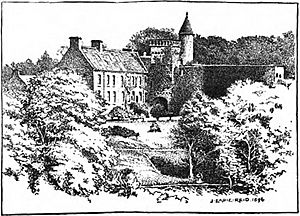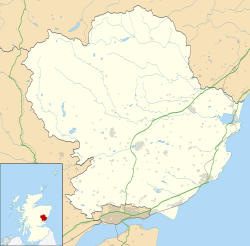Airlie Castle facts for kids
Quick facts for kids Airlie Castle |
|
|---|---|
| Airlie, Angus, Scotland | |

Drawing of Airlie Castle
|
|
| Coordinates | 56°39′22″N 3°09′18″W / 56.6562°N 3.1551°W |
| Type | Mansion |
| Site information | |
| Open to the public |
Private |
| Site history | |
| Built | 15th century; rebuilt 19th century |
| Materials | Stone |
Airlie Castle is a beautiful old mansion in Airlie, Angus, Scotland. It sits close to where the Isla and Melgund rivers meet. This historic place is about 9 kilometers west of Kirriemuir. A castle was first built here around 1432. It was later burned down in 1640. Much later, around 1792-1793, a new mansion was built using parts of the old castle's ruins. People still live there today! The main house and its stables are considered important historic buildings. Its gardens are also special, listed in the Inventory of Gardens and Designed Landscapes in Scotland.
Contents
The Castle's Early Days
Building a Stronghold
In 1432, King James I of Scotland gave land to Walter Ogilvy of Lintrathen. Walter was a very important person, known as the Lord High Treasurer of Scotland. This meant he managed the country's money.
Walter Ogilvy decided to build a castle on this land. He chose a spot where the River Isla and the Melgam Water met. The castle was built on a high point. It had a steep drop of about 400 feet down to the rivers below. This made it very hard for enemies to attack.
Protecting the Castle
To make the castle even safer, a moat was dug on its eastern side. A moat is a deep, wide ditch, often filled with water, that surrounds a castle. This made Airlie Castle a very strong fortress. It became the main home for the powerful Clan Ogilvy.
In 1564, James Ogilvy, 5th Lord Ogilvy of Airlie had plans to rebuild parts of the castle. The original castle had a rectangular courtyard. Its walls were incredibly thick, about three meters (or 10 feet) wide!
Today, part of the original east wall still stands. It is about 36 meters (118 feet) long and 9 meters (30 feet) tall. At the north end of this wall, there is an entrance gate. A square tower now sits on this gate, but it was added later than the first courtyard.
A Time of Conflict
The Ogilvies and King Charles I
In 1639, King Charles I gave James Ogilvy a special title: the 1st Earl of Airlie. This was a big honor! However, James Ogilvy refused to sign something called the National Covenant. This was an agreement that many Scots signed to protect their religion and freedoms.
During a period known as the Wars of the Three Kingdoms, the Ogilvy family supported King Charles I. They were known as Royalists, meaning they were loyal to the King.
The Castle's Destruction
In 1640, soldiers who supported the Parliament, called Parliamentarians, attacked Airlie Castle. These troops were led by Archibald Campbell, 8th Earl of Argyll. They completely destroyed the castle.
A famous old song, called "The Bonnie Hoose o' Airlie", tells the story of this sad event. Campbell's troops also burned down other castles belonging to the Ogilvies, like Craig and Forter.
A New Beginning
After the War
After the castle was destroyed, the Ogilvy family did not rebuild it right away. James Ogilvy, who was the grandson of the first Earl, got involved in a rebellion called the Jacobite rising of 1715. This was a fight to bring a different royal family back to the throne.
Because of his involvement, James Ogilvy lost his right to inherit his father's title and lands. This is called being "attainted." Even though he was later pardoned in 1725, the castle was taken by King George II.
The Mansion is Built
Years later, in 1778, David Ogilvy also received a pardon. He had been living in exile in Versailles, France. He was finally able to return to Scotland.
Between 1792 and 1793, David Ogilvy had a new mansion built on the site of the old castle. This new house used parts of the old castle walls that were still standing. This is why Airlie Castle today looks like a grand mansion, but it still has pieces of its ancient past.


